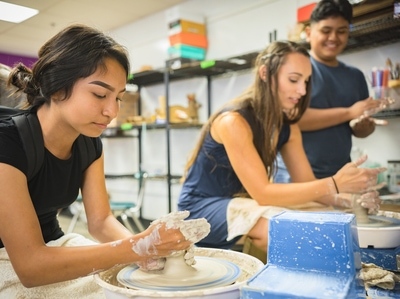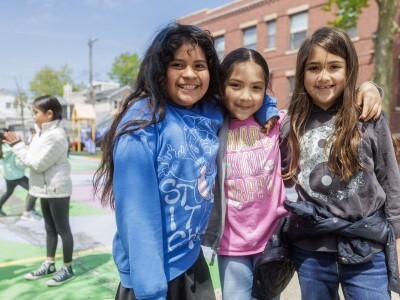The Case for Curiosity
Topics

Today’s learners face an uncertain present and a rapidly changing future that demand far different skills and knowledge than were needed in the 20th century. We also know so much more about enabling deep, powerful learning than we ever did before. Our collective future depends on how well young people prepare for the challenges and opportunities of 21st-century life.
Three axioms to help prevent schools from producing uncurious humans
In the American school system we’ve mostly left behind the “empty vessel” model of learning. Instead, we hope that kids get shaped by learning experiences and participate in that very shaping. We hope that their actualization will be self-actualization. We hope for their engagement, their fascination, and, most of all, their curiosity. This isn’t just for them. It’s for us as a society. If we’re to continue, especially as a moderately viable democracy, we need curious people among us!
It’s our job—as parents, teachers, mentors, etc.—to inspire it.
Consider: When in your own life has the most vital, vibrant, and essential learning taken place? The kind of learning that leaves you sweating, fulfilled, and wanting a burger (possibly Beyond)? What’s the common element in all the great learning experiences of your life?
Nine out of ten people I ask this question tell me a great learning experience starts with them deciding I want to learn about ____________. This is notable because seldom do kids in our schools have experiences that begin with them making a decision about their own learning. In other words, how often do we start our teaching with a kid’s curiosity?
Not often enough! And—if we want all kids to have powerful, effective, and joyful learning experiences—we need to get better at making that happen. To that end, I present three axioms about curiosity.
Axiom 1: Curiosity Is the First Cause of All Learning
Curiosity is not the engine but the fuel; not the sun but the hydrogen; not the sail but the wind; not the zygote but the twinkle in the lovers’ eyes. It is the driving force behind humanity’s greatest efforts, and, thus, our schools’ best aspirations.
Importantly, though, while curiosity is the first cause of learning, any number of things can motivate curiosity. Curiosity may be the product of wonder. That’s what we’re always hoping for. But it may also be the product of coercion. I was curious about the drivers’ manual for the State of New Jersey because I wanted to drive a car. I was curious about stats because I needed it to enter my grad program. I was curious about the sound under my house because I needed to know whether to call a plumber or exterminator. I was curious about various religious texts because I wished to achieve some essential sense of comfort in the universe. I am curious about many things for no discernable reason at all. All of these are valid forms of curiosity and all lead to learning at some level or other. But….
Axiom 2: Some Forms of Curiosity Are More Desirable than Others
We may desire to learn something for reasons intrinsic or extrinsic. Learning will result, but not learning of the same caliber.
Schools and teachers regularly make hierarchies of different types of curiosity. We make value judgments and decide on compromises. A taxonomy might divide curiosity as above: extrinsic and intrinsic. We might subdivide further. Curiosity may be driven by a physical need. (Where’s the bathroom?) Curiosity may be prompted by fear. (How am I going to pay back this loan to Tony Soprano?) Curiosity may be prompted by a desire for status. (What do I have to know to stay in the class top ten?) Curiosity may be inspired by a desire to impress. (What does that hot guy like?) Curiosity may be inspired by artistic or emotional desires. (How can I play guitar to make that kind of music?)
Over the past twenty years, we’ve idealized “self-directed learning” and the “life-long learner,” because, in our heart of hearts, we want to have a society filled with people who want to learn. Every teacher has the experience of seeing the light go on behind a kid’s eyes. It’s magical. Suddenly, the kid is taking hitherto unfamiliar ideas and taking ownership of them.
We love intrinsic curiosity.
“What ever happened to learning something just for the joy of learning?” we ask judgmentally—while compelling attendance. We try to compel this highest level of curiosity from kids, which is impossible. Compulsion is the very opposite of intrinsic. We may bemoan the kid who is doing it “just for the grade,” but we will brag on that kid, pass them through, and write letters of recommendation. How could we not? If we offer a sanction—pass or fail—how can we blame the kid for acting according to that sanction?
Still, though we are a system of entirely extrinsic motivations, intrinsic curiosity remains at the center of our devotions. Learning for its own sake, we believe, is self-evidently better than its more utilitarian varieties.
We refer to our own experiences. The best learning experiences of our lives begin with the fire of our own fascination, and any agreement between our fascination and the goals of the school system is, at best, happenstance.
It does not have to be that way. Can we—as teachers, parents, etc.—increase the probability that learning will tap into those things closest to our students’ hearts? What they love. Who they are. Where they come from. Where they want to go. Can one of the criteria of being a good teacher be the ability to draw kids into the world of learning, or whipping them into a frenzy, or sending them down a rabbit hole?
It is possible. It is necessary. It is ethically required that we do so.
Axiom 3: Curiosity Is the Business of Schools
The first job of the school is to promote, foment, and incite the highest levels of curiosity in the highest number of students. It is the prize we ought to keep our eyes on.
If curiosity—i.e., the dissatisfaction of not knowing—is the key to meaningful learning, then as schools we are at our best when we help teachers and get out of the way; as teachers we are at our best when we tell great stories, ask compelling questions, talk to kids, and form solid relationships. All of us are at our worst when we put up barriers to the promotion and satisfaction of curiosity. Functionally, gatekeepers are part of the wall.
Should that be our criteria for structural and pedagogical efficacy? What effect do things like scheduling, scope and sequence, grades, punishments, class size, eligibility, dress codes, and compulsory attendance have on a kid’s curiosity? What about curricula, instruction, and assessment? Those are factors over which we have nominal control. What happens when we consider bullies, hunger, or poverty? Teen romance and work commitments? Policies and initiatives that shift with the wind, politicians and administrators who insist there is no wind, and teachers who seek shelter from the storm? What happens to curiosity then?
We can’t answer these questions quantitatively because no one has persuasively figured out how to express curiosity in quantitative measures. On a qualitative level, you are already forming your own judgements.
Conclusion: Better Schools Promote Curiosity
Perhaps this seems unrealistic to you. If all of the above is true, is it logically necessary that all educational decisions be made starting at the kids’ fascination? Isn’t it logically necessary, if you buy my argument, that we end compulsory attendance? Is it ethical, after all, to require someone to be fascinated by something? To reward if they are and punish if they are not?
Because of the many conflicting goals of schools, compromises have to be made. This is what they call “obvious.” But how many compromises? Not as many as you think.
For example, what would we have to do to create a school in which all kids:
- Have had their curiosity stoked to the highest degree.
- Have the temperament and skills to address that curiosity.
- Feel a sense of belonging, ownership, and citizenship within every level of society (self, school, local, state, nation, world).
- Know and appreciate the traditions, customs, and expected practices held by the various peoples they will likely encounter in their lives.
- Understand and recognize the importance and value of difference.
- Master an agreed upon (or negotiated) body of information and skills.
- Know how to utilize that body of information and skills in their lives.
Are the truths that we hold to be “self-evident” indeed true, or are they aspirations offered to comfort an under-inspired populace? There are no perfect schools—there is no perfect learning—but there are better schools and better learning. They have particular characteristics and the closer we get to them, the better we’re doing—i.e., the probability of more kids having happier and more successful lives increases considerably.
The promotion of curiosity is one of those characteristics. As teachers we all know when curiosity is happening. Is there a structural response to this? Is there professional development that addresses this? A non-profit curiosity coalition? Perhaps it’s a matter of hiring practices—bringing the curiosity evangelists into our faculties. Perhaps it’s a matter of changing our mindsets and practices, one teacher at a time.
This article was originally published in Brain Labs on October 24, 2024.
Photo at top by Isabella Fischer on Unsplash (altered by the author).




